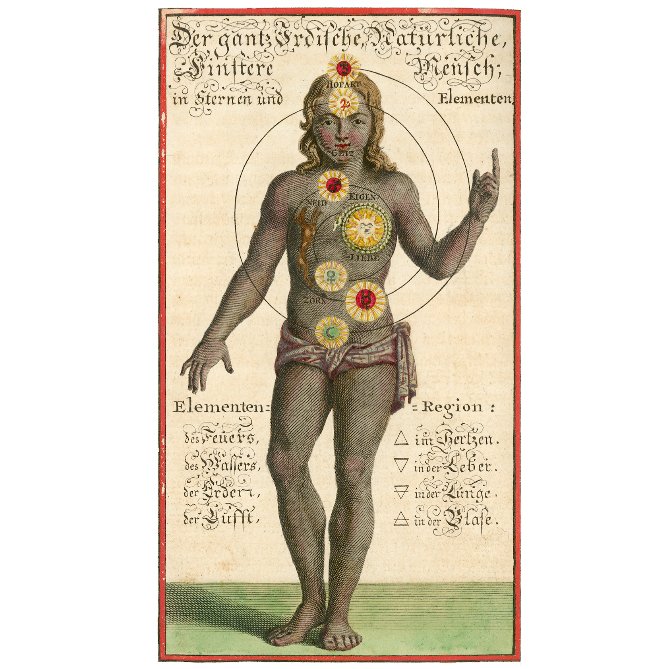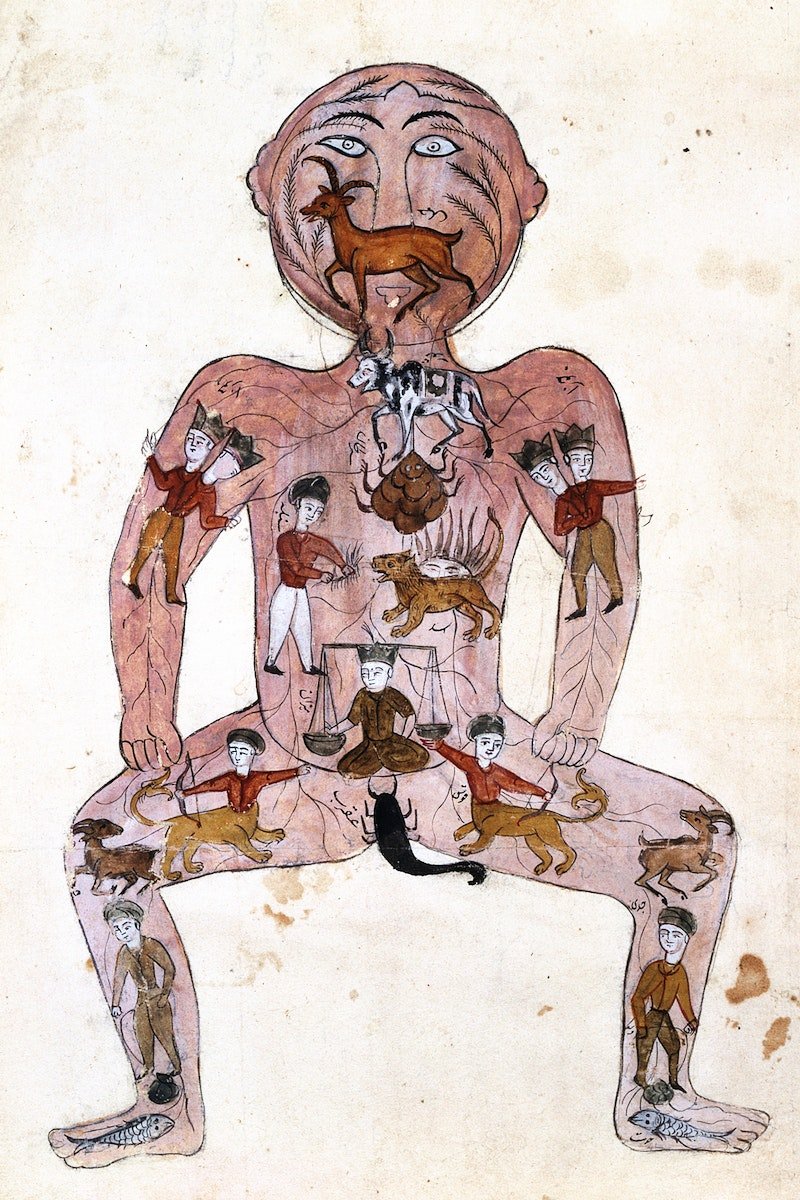 Image 1 of 2
Image 1 of 2

 Image 2 of 2
Image 2 of 2



Medieval Medicine and the Magical Body with Art Historian Brenda Edgar, Begins July 8
Six-week class taught online via Zoom
Tuesdays, July 8 - August 12, 2025
6 pm - 7:30 pm ET
$120 Paid Patreon Members / $140 General Admission
PLEASE NOTE: All classes will also be recorded and archived for students who cannot make that time.
Medieval scientific thought was based upon the concept of Intelligent Design. In this model, Christ was the ultimate Architect of the Universe, as well as the only True source of healing. However, it was expected that people would pursue the more mundane avenues for healing in addition to appealing to the Divine Doctor himself. In this course, we’ll investigate the medieval understanding of how the world worked, as well as the medical theories and practices of the period.
Equal parts science and esoterica, medicine in the European Middle Ages (roughly 500-1500 AD) was ultimately rooted in Ancient Greek and Roman writings, influenced by Arabic thought, and translated into a Christian framework. We’ll learn the basics, including the theory of humors and the relationships between the elements, months, zodiac signs, winds, lunar cycles, and ages of man. We’ll also look at the primary diagnostic practices and treatments of the period, including urinalysis, bloodletting, and surgery.
Along the way, we’ll discover how medieval people used natural substances, including plants, animals, stones, and metals, to treat various illnesses and humoral imbalances. We’ll also examine religious healing practices such as prayer to healing saints, pilgrimage, and relic veneration, which were often used as adjuncts to purely physical approaches, or as desperate measures when more traditional treatments had failed.
The course will end with an introduction to the major medieval epidemics and pandemics, focusing on leprosy and bubonic plague, with an analysis of how medieval people understood and experienced these scourges.
The optional final project will invite you to be your own medieval doctor by devising a complete medieval medical treatment plan for a malady of your choice!
Brenda Edgar is an Art Historian in Louisville, Kentucky. In addition to her Morbid Anatomy courses, she teaches for Indiana University and offers a free monthly talk series, "Art History Illustrated," at the Cultural Arts Center in New Albany, Indiana. Brenda is also a very busy yoga teacher and local tour guide.
Images: Theosophia practica, Johann Georg Gichtel; A woodcut by Leonhard Thurneysser (1531-1596), circa 16th century, depicting the four elements of the Greek humoral theory (blood, phlegm, cholera [yellow bile], and melancholy [black bile]) on which they were based 14th century diets.
Six-week class taught online via Zoom
Tuesdays, July 8 - August 12, 2025
6 pm - 7:30 pm ET
$120 Paid Patreon Members / $140 General Admission
PLEASE NOTE: All classes will also be recorded and archived for students who cannot make that time.
Medieval scientific thought was based upon the concept of Intelligent Design. In this model, Christ was the ultimate Architect of the Universe, as well as the only True source of healing. However, it was expected that people would pursue the more mundane avenues for healing in addition to appealing to the Divine Doctor himself. In this course, we’ll investigate the medieval understanding of how the world worked, as well as the medical theories and practices of the period.
Equal parts science and esoterica, medicine in the European Middle Ages (roughly 500-1500 AD) was ultimately rooted in Ancient Greek and Roman writings, influenced by Arabic thought, and translated into a Christian framework. We’ll learn the basics, including the theory of humors and the relationships between the elements, months, zodiac signs, winds, lunar cycles, and ages of man. We’ll also look at the primary diagnostic practices and treatments of the period, including urinalysis, bloodletting, and surgery.
Along the way, we’ll discover how medieval people used natural substances, including plants, animals, stones, and metals, to treat various illnesses and humoral imbalances. We’ll also examine religious healing practices such as prayer to healing saints, pilgrimage, and relic veneration, which were often used as adjuncts to purely physical approaches, or as desperate measures when more traditional treatments had failed.
The course will end with an introduction to the major medieval epidemics and pandemics, focusing on leprosy and bubonic plague, with an analysis of how medieval people understood and experienced these scourges.
The optional final project will invite you to be your own medieval doctor by devising a complete medieval medical treatment plan for a malady of your choice!
Brenda Edgar is an Art Historian in Louisville, Kentucky. In addition to her Morbid Anatomy courses, she teaches for Indiana University and offers a free monthly talk series, "Art History Illustrated," at the Cultural Arts Center in New Albany, Indiana. Brenda is also a very busy yoga teacher and local tour guide.
Images: Theosophia practica, Johann Georg Gichtel; A woodcut by Leonhard Thurneysser (1531-1596), circa 16th century, depicting the four elements of the Greek humoral theory (blood, phlegm, cholera [yellow bile], and melancholy [black bile]) on which they were based 14th century diets.
Six-week class taught online via Zoom
Tuesdays, July 8 - August 12, 2025
6 pm - 7:30 pm ET
$120 Paid Patreon Members / $140 General Admission
PLEASE NOTE: All classes will also be recorded and archived for students who cannot make that time.
Medieval scientific thought was based upon the concept of Intelligent Design. In this model, Christ was the ultimate Architect of the Universe, as well as the only True source of healing. However, it was expected that people would pursue the more mundane avenues for healing in addition to appealing to the Divine Doctor himself. In this course, we’ll investigate the medieval understanding of how the world worked, as well as the medical theories and practices of the period.
Equal parts science and esoterica, medicine in the European Middle Ages (roughly 500-1500 AD) was ultimately rooted in Ancient Greek and Roman writings, influenced by Arabic thought, and translated into a Christian framework. We’ll learn the basics, including the theory of humors and the relationships between the elements, months, zodiac signs, winds, lunar cycles, and ages of man. We’ll also look at the primary diagnostic practices and treatments of the period, including urinalysis, bloodletting, and surgery.
Along the way, we’ll discover how medieval people used natural substances, including plants, animals, stones, and metals, to treat various illnesses and humoral imbalances. We’ll also examine religious healing practices such as prayer to healing saints, pilgrimage, and relic veneration, which were often used as adjuncts to purely physical approaches, or as desperate measures when more traditional treatments had failed.
The course will end with an introduction to the major medieval epidemics and pandemics, focusing on leprosy and bubonic plague, with an analysis of how medieval people understood and experienced these scourges.
The optional final project will invite you to be your own medieval doctor by devising a complete medieval medical treatment plan for a malady of your choice!
Brenda Edgar is an Art Historian in Louisville, Kentucky. In addition to her Morbid Anatomy courses, she teaches for Indiana University and offers a free monthly talk series, "Art History Illustrated," at the Cultural Arts Center in New Albany, Indiana. Brenda is also a very busy yoga teacher and local tour guide.
Images: Theosophia practica, Johann Georg Gichtel; A woodcut by Leonhard Thurneysser (1531-1596), circa 16th century, depicting the four elements of the Greek humoral theory (blood, phlegm, cholera [yellow bile], and melancholy [black bile]) on which they were based 14th century diets.
